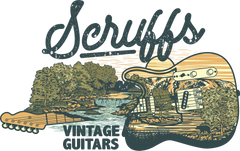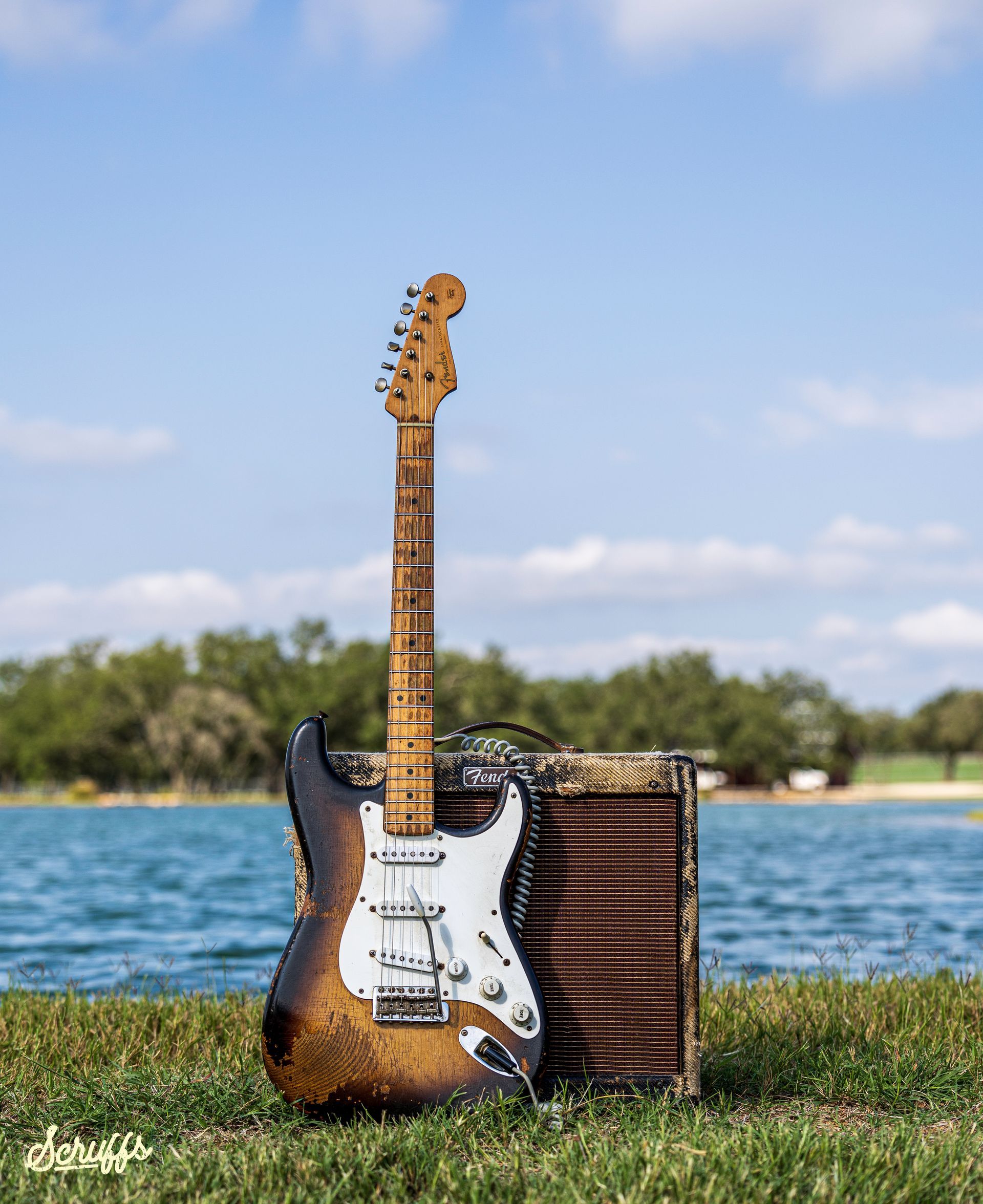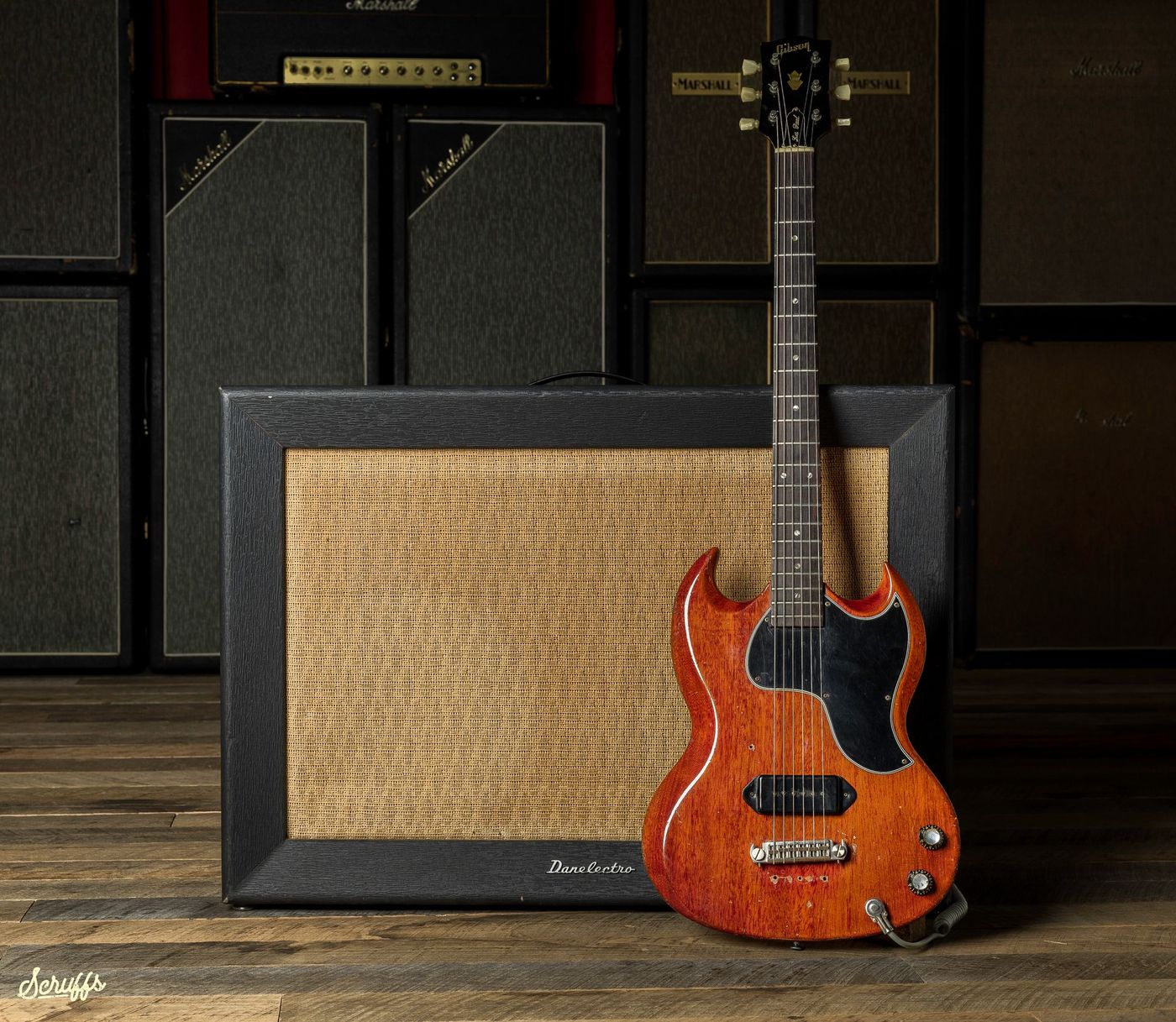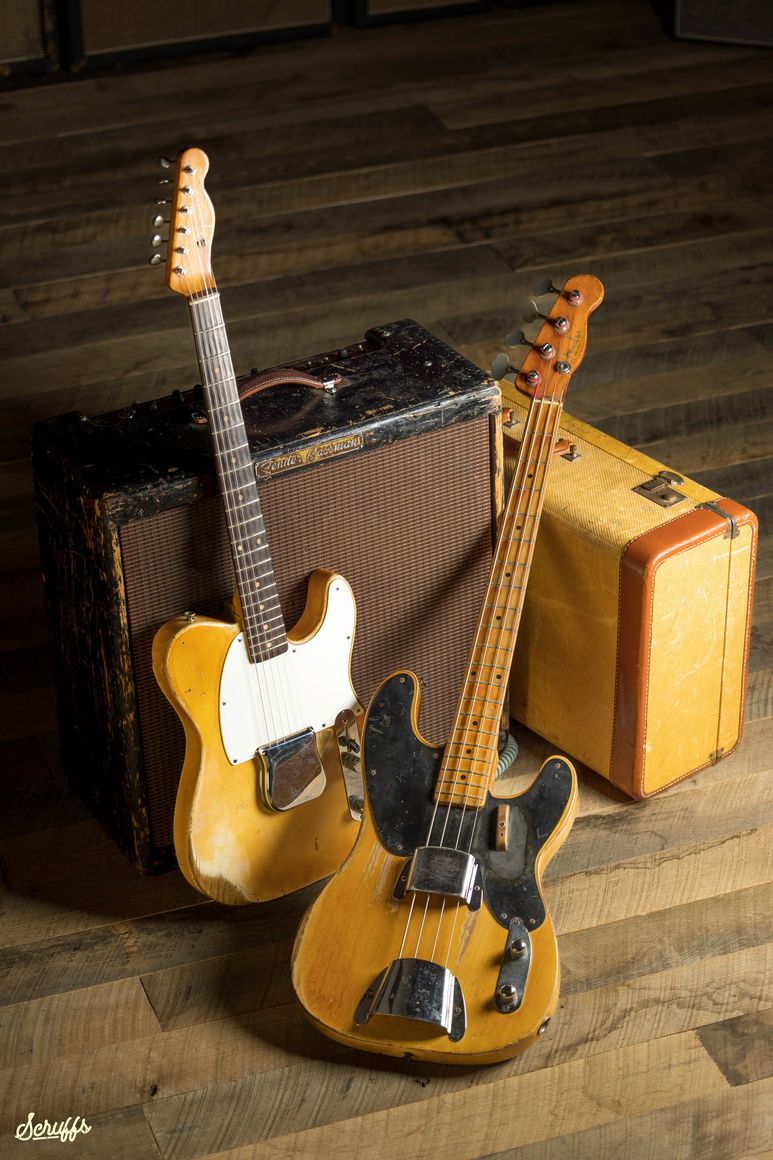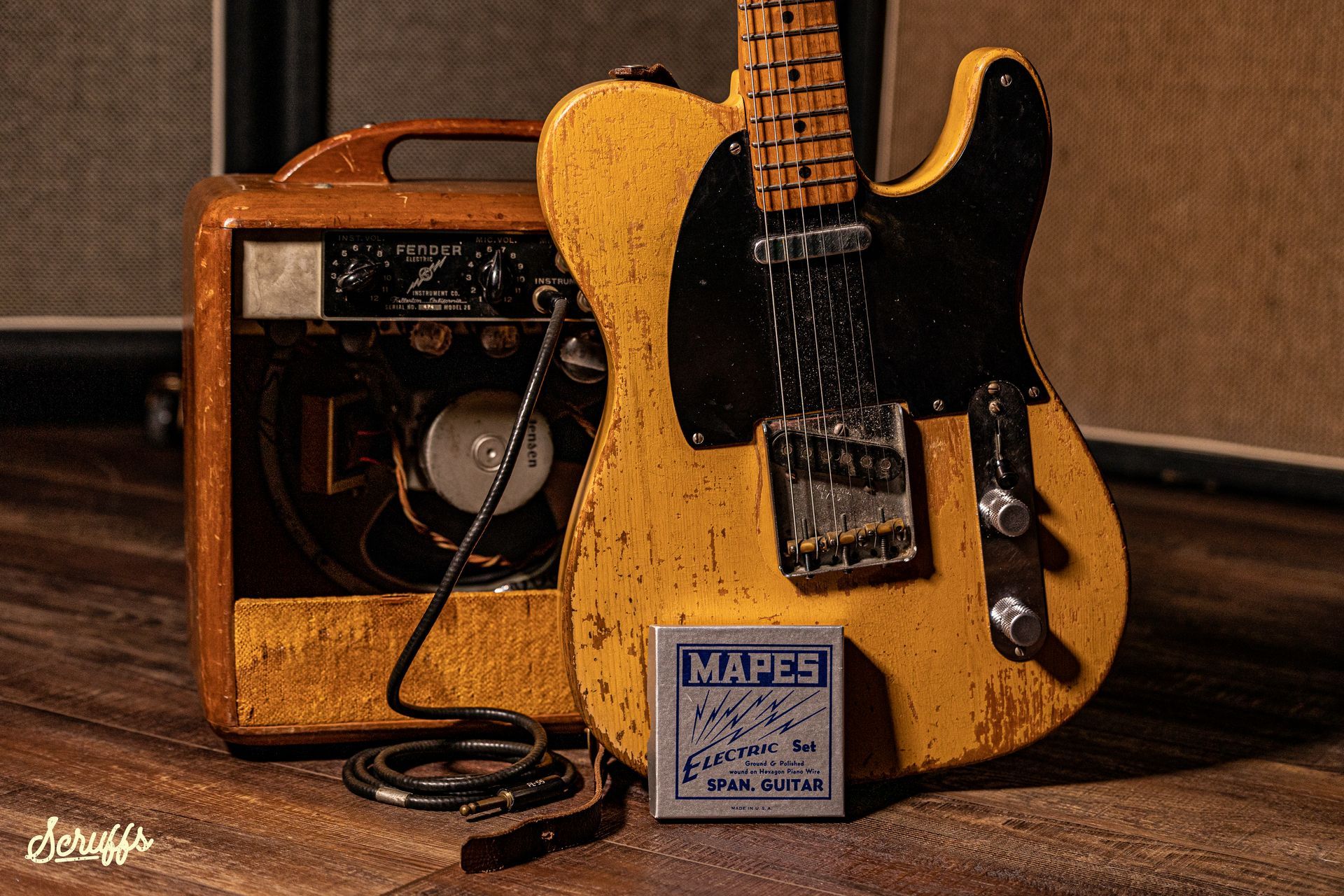This photo holds a special place in my heart as one of my all-time favorites. While it may not possess technical or professional qualities, the overall vibe is simply captivating. A closer look reveals some fascinating details - the guitar, a 1951 Fender Broadcaster, had its "Broadcaster" logo section cut off by hand due to a trademark lawsuit from Gretsch's "Broadkaster" drum line. Today, these guitars go by the name "Nocaster". The amplifier, a 1946 Fender Model 26 Deluxe, adds to the vintage feel. Original Mapes Strings that were included with Broadcasters, Nocasters, and Telecasters. The cable, a PL-55 military cable, would have been shipped with the first Broadcasters and Nocasters.
Welcome
Welcome to our photo gallery. Here, you will find a mix of items from our personal collection as well as gear that has been sold through our shop.
Vintage Fender Esquires & Marshall Amps: A Rare Collection
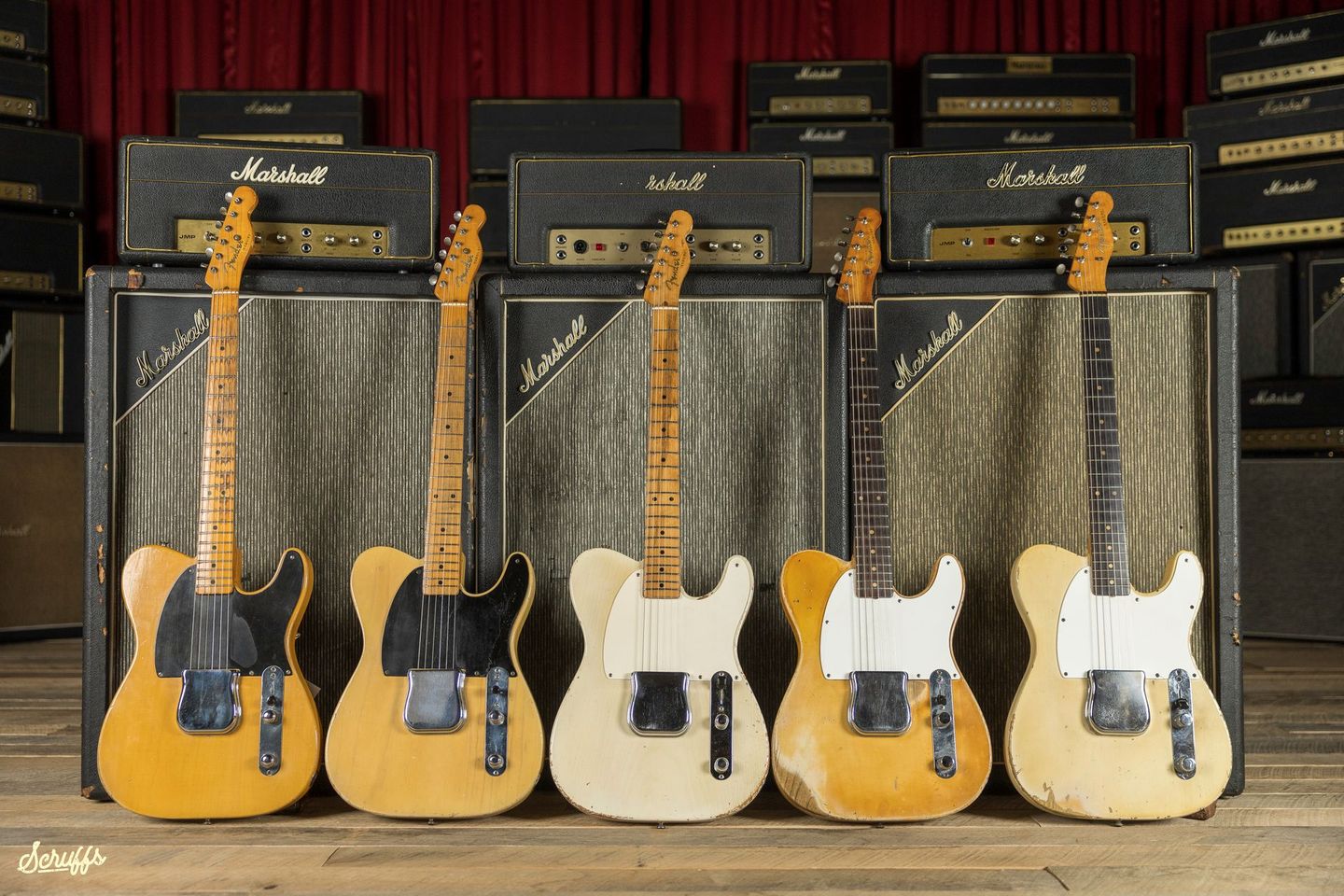
It’s funny how things tend to come in clusters. The old “when it rains, it pours” adage definitely applied when we here at Scruff’s had the rare fortune of having five vintage Fender Esquire model guitars in stock at the same time.
These five incredible instruments cover almost all of the distinct historic changes in the first 15 years or so of this model’s history
All the way to the left is a 1952 model, distinguished by its use of slot head screws almost throughout. A lightweight guitar (none of these five guitars is much over 7 lbs) with a big, comfortable neck and a nice, deep orange patina.
Next in line is a 1953 model Esquire. It seems to us that ‘53 was the year Fender Teles and Esquires became really consistent. While neck sizes, weight, and even the tone can vary quite a bit in earlier years, by 1953 necks are typically medium big with a tiny hint of “V” to their shape and generally little taper from the first to the twelfth fret. Screws are now all Phillips head.
Next to the ‘53 is a ‘55 model Esquire. Gone is the black bakelite pickguard that made way to this single ply white guard in the second half of 1954. The bridge plate no longer carries the serial number. It is now on the neck plate.
The finish is a much more pale off-white translucent blonde. The neck shape is medium big and round. This guitar is from the earlier part of 1955 and still sports essentially the same flat pole pickup as the blackguards. Later on in 1955 the D and G magnet pole pieces would be raised to improve string balance (not that string balance was ever an issue with the flat pole pickups).
To the right of the 1955 Esquire is a 1960 model. It represents what could be considered the most significant step in the evolution of not just this model, but the entire Fender line up. 1958 saw the introduction of the rosewood fingerboard. All Fender guitars prior had a one piece maple neck. When they switched to rosewood fingerboards, they glued a thick slab of Brazilian rosewood to a flat maple blank, hence the moniker “slab board neck”.
These early slab board necks can be surprisingly small and thin at the first fret, with a substantial taper in thickness towards the body. From 1958/1959 the neck gradually became a bit fuller again, with the last slab board necks in early to mid ‘62 generally being the biggest.
Speaking of which, in the second half of 1962 Fender changed neck construction yet again and abandoned the slab board (except, interestingly for they student models MusicMaster and DuoSonic). Instead they introduced what’s become known as a “curved board”, or “veneer board” neck. As the name implies, the maple neck base has a curved fingerboard side, with a matching, much thinner rosewood fingerboard glued on top of it. This can be seen by either looking at the headstock or butt end of the neck.
Representing this era is the 1963 model Esquire at the right hand side of this lineup.
Behind the guitars are three 1966 era “pinstripe” 1x18 Marshall speaker cabinets. We here at Scruff’s happen to think these are some of the coolest looking cabs ever made.
The proportions and the corner logos just do it for us. Equipped with huge spider-framed Celestion 100 Watt G18 speakers, these cabs were meant for bass guitar, and they sound rather spectacular in that application. What is surprising is how good they sound for guitar as well!
On top of the cabs are two 1970 Marshal Lead and Bass amplifiers as well as an impossibly rare 1967 Marshall 20 Amplifier. These amps are equipped with a pair of cathode biased EL84 power tubes for around 20 Watts of power and deliver all of the legendary vintage Marshall tone at less-than-earsplitting volume levels. If you have a Vintage Fender Esquire and want to sell it or have photos taken send us an email or call us!
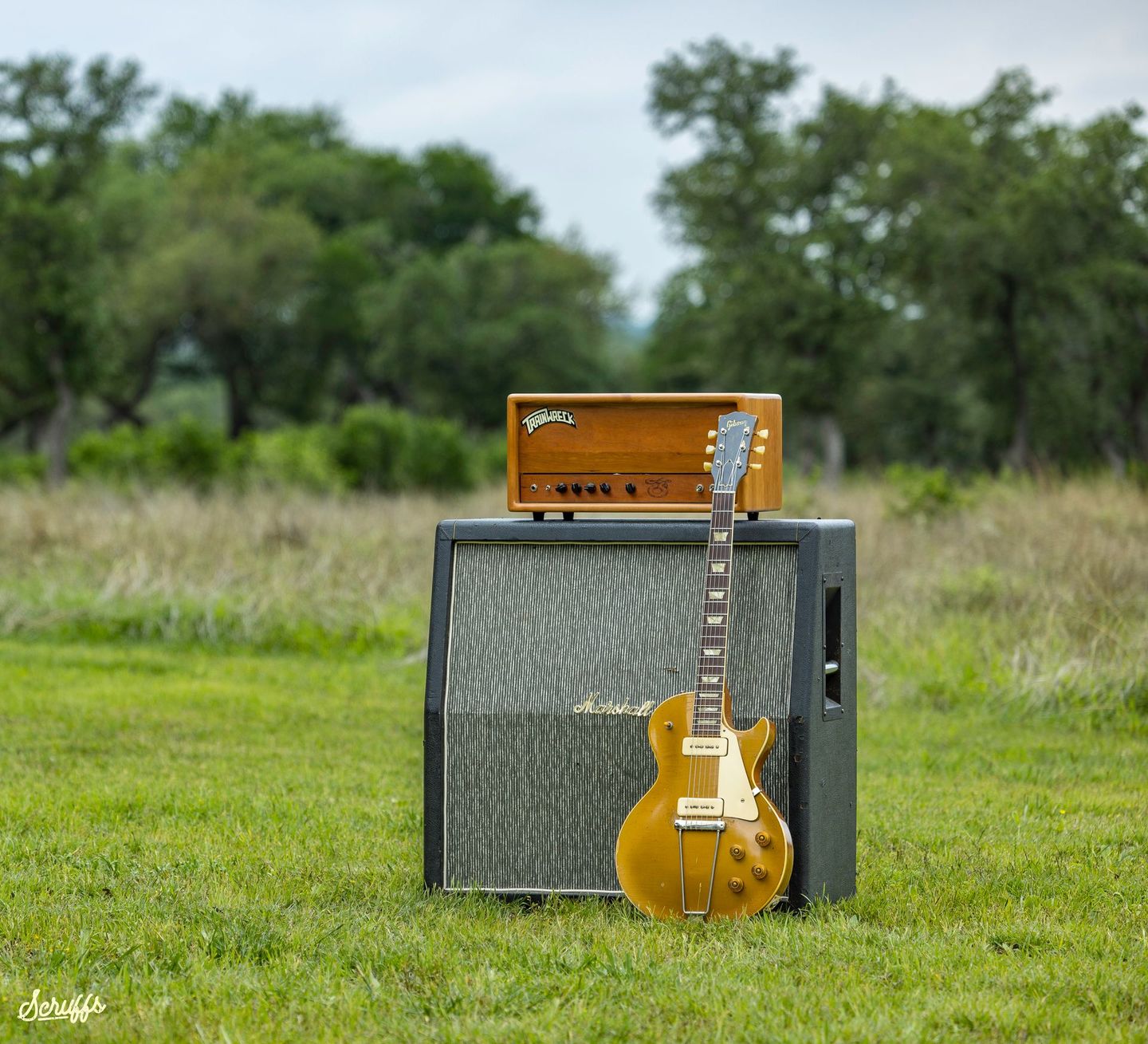
Lucy and a 1952 Les Paul
1958 Gibson Les Paul
“Remember that day we first played that killer ‘58 ‘burst though that ‘66 JTM45?” Yes, we do, and we always will. It was just one of those moments that sears itself into memory. It just sounded so right.
I mean, what can be said about this pairing of a PAF equipped Les Paul into a vintage Marshall? It is the sound or Rock & Roll, cliched as that may sound. It just is. These two react in a way that can only be described as “ magical”, when the air becomes electric and the guitar and amp start talking to each other. Playing becomes effortless and everything happens exactly the way you think it should. Notes bloom into harmonic feedback at will, and a simple adjustment of the player’s touch can take the tone from clean and crystal clear all the way to full on overdrive. It can sound sweet and delicate, or aggressive and searing, and everything in between. If you are a guitar player who loves electric guitar tone, this is pretty much Nirvana.
If you have a Vintage Gibson or Marshall and want to sell it or have photos taken send us an email or call us!
Are you seeing double?
Believe me, your eyes are not deceiving you. On the right-hand side of the first photo, you'll see two mammoth guitars - a 1972 Gibson EDS-1275 and a 1968 Gibson EBS-1250. Despite their size, they are both outshone by the ever-reliable Marshall JTM-45. The JTM-45 that sits atop the left cabinet is a 1963 model and happens to be one of the first ever made by Marshall. Meanwhile, the JTM-45 on the right cabinet, previously owned by Peter Frampton, is from 1966. The cabinets themselves are equally impressive. On the right, we have a 1971 Model 1990 8x10 cab and a 1969 Model 2032 4x12 cab. Moving to the second photo on the right, we have the Frampton JTM-45 perched on top of the Model 1990 cab, while a rare 1967 Marshall Model 1917 with an original 1969 Model 2022 4x10 cab completes the picture. The only odd one out is a 1961 Les Paul that remains in its original condition.
Surf or Twang?
Are you struggling to choose between two iconic vintage guitars - the 1963 Fender Jazzmaster and the 1967 Fender Custom Telecaster? These rare instruments offer a distinctive sound that is unmatched. The smooth and mellow tones of the Jazzmaster make it a favorite of surf music enthusiasts, while the Telecaster's bright and twangy sound has become synonymous with country and rockabilly music. So, which one resonates with you? Are you drawn to the Telecaster's classic style and cowboy vibe, or do you prefer the Jazzmaster's laid-back and modern design? The choice is yours.
